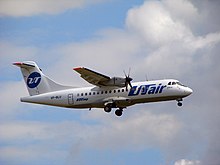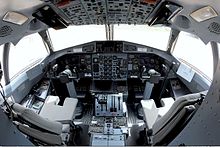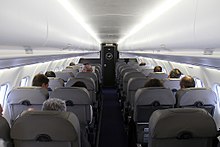ATR 42
| ATR 42 | |
|---|---|
 ATR 42-600 in ATR factory painting |
|
| Type: | Regional airliner |
| Design country: | |
| Manufacturer: | |
| First flight: |
August 16, 1984 |
| Commissioning: |
1985 |
| Production time: |
In series production since 1984 |
| Number of pieces: |
477 (as of August 28, 2019) |
The ATR 42 is the smaller model of two turboprop regional airliners from the Franco-Italian manufacturer consortium Avions de Transport Régional . The larger model ATR 72 is the stretched version of the ATR 42 .
history
On October 29, 1981, the development program for the first joint product of Avions de Transport Régional (ATR) began. The ATR 42, the prototype of which then had its maiden flight on August 16, 1984, was ready for series production and certified from September 1985. The final assembly and flight testing of the civil passenger aircraft variant took place in Toulouse , that of the military and civilian cargo variants in Naples .
The aircraft type is mainly used for short-haul passenger transport. After converting the airframe, the machines can be used as cargo aircraft.
Air Littoral (France) was the first airline to put the aircraft into service on December 3, 1985. Since then, it has been in use almost unchanged - with the exception of the change in the propellers.
The older machines (ATR 42-300, from 1985 and ATR 42-320, from 1987) have four-bladed propellers. In October 1995, the improved version ATR 42-500 began regular service with Air Dolomiti . The improvements (according to the manufacturer's website) include the cabin interior, an increased take-off weight MTOW , more powerful engines and more modern six-bladed propellers. This cruising speed and range to be increased and the fuel consumption lowered the aircraft are landing or the start noticeably quieter.
In October 2019 ATR announced that it would produce a STOL version of the ATR 42-600 - the ATR 42-600S. At 800 meters, this requires a runway that is 250 meters shorter, but can only transport 40 instead of 50 passengers. However, it offers 50 seats, whereby fully occupied it then needs 900 meters to start. This variant was ordered 20 times before the program started. First customers are Air Tahiti and Elix Aviation.
By August 2015, 438 copies of the ATR 42 had been delivered. In the middle of 2015 the total of deliveries of the "family members" ATR 42 and ATR 72 amounted to 1,202 pieces.
construction
By installing so-called active noise reduction systems, the propeller noise inside the cabin was also significantly reduced.
One advantage of the turboprop aircraft compared to the regional jets is the significantly shorter take-off and landing distance, which makes them interesting for use at smaller airports. Only machines specially designed for this purpose, such as the BAe-146 , also known as Jumbolino , achieve comparable values for take-off and landing routes .
The main advantage of a turboprop aircraft is the significantly lower fuel consumption per tonne-kilometer. At the time of its appearance, it set standards here - the ATR 42 consumes around 1.8 liters of kerosene per passenger and 100 km at full capacity - this corresponds to half the consumption of a modern jet.
In regional air traffic, the ATR 42 has a clear speed disadvantage compared to the regional jets operated with jet engines . With the current engines, the ATR 42 only reaches speeds of up to 556 km / h. Current regional jets reach speeds of over 700 km / h, which are in no way inferior to those of medium-haul aircraft. Increased use and the availability of various regional jets (such as the Bombardier CRJ200 or Embraer's regional jets ) called the future of turboprop aircraft into question. In view of rising fuel prices, however, turboprop engines experienced a certain boom in 2005, which led to increasing demand from both ATR and Bombardier (for the DHC-8 series).
The STOL variant, the 42-600S, differs in the software of the engines, which can call up more power (2750 PS instead of 2400 PS) at take-off, automatic brakes, additional spoilers and a larger rudder which is supposed to improve handling.
Military versions
From the ATR 42, Alenia Aeronautica developed, in addition to the military cargo aircraft, a military transporter called ATM 42, which is equipped with a rear ramp and the SAR 42 as a search and rescue version based on the ATR 42-400.
There is also a maritime reconnaissance variant called the ATR 42 MP Surveyor . It serves as a patrol aircraft and is mainly used by coast guards or similar organizations. The aircraft is equipped with two turboprop -Triebwerken type Pratt & Whitney Canada PW100 equipped. There is no auxiliary power unit (APU). The propeller of the right engine can be fixed on the ground with the help of a prop brake. The two shafts of the so-called core engine continue to run at idle speed and supply electricity and bleed air for the air conditioning and other systems. Aircraft of this type were procured by the Italian Guardia Costiera and the Guardia di Finanza , and further aircraft went to Nigeria ( Nigerian Air Force ) and Libya ( General Security Agency ).
Civil and military cargo version
Various companies have also converted the ATR 42 into a freighter ATR-42F. The best-known version is a bulk freighter , in which the entire cabin is cleared out and divided into different freight compartments with vertical nets. The ATR 42 can economically transport up to around five tons of freight. An ATR 42-320 as a freighter is used, for example, by ASL Airlines Switzerland (formerly Farnair ) based in Basel, Switzerland.
Incidents
Up to and including December 2017 there were 33 total losses. In 11 of them, 272 people were killed. Examples:
- On October 15, 1987, an ATR 42-300 of the Aero Trasporti Italiani ( aircraft registration I-ATRH ) crashed on the flight from Milan Linate Airport to Cologne / Bonn at the Conca di Crezzo due to icing . All 37 occupants died (see also Aero Trasporti Italiani flight 460 ) .
- On August 21, 1994, the autopilot of a Royal Air Maroc ATR 42-300 launched in Agadir was switched off at an altitude of 16,000 feet. The plane took a dive and crashed to the ground. All 44 people on board died. The presumed cause of the accident was a suicide by the flight captain (see also Royal Air Maroc flight 630 ) .
- On July 30, 1997, an ATR 42-500 from Air Littoral (F-GPYE) touched down significantly too late and too quickly when landing at Florence Airport . It rolled over the end of the only 1030 m short available landing stretch and crashed into the embankment of the adjacent motorway. One of the pilots was killed, the other 16 occupants survived (see also Air Littoral Flight 701 ) .
- On July 28, 1999, an employee of the ground crew at Little Rock National Airport was killed when he ran into the running propeller blade of a regional machine of the type ATR 42-500 of the Continental Express , which had just arrived from Houston (see also Continental Express Flight 3402 ) .
- On October 11, 1999, an Air Botswana pilot stole an ATR 42-320 (A2-ABB) and, while flying alone, deliberately steered it into two empty ATR 42s on the ground at Gaborone Airport after his demands for talks with the President of Botswana and other decision-makers had not been met (see also Air Botswana accident 1999 ) .
- On November 12, 1999, a United Nations chartered ATR 42-300 of Si Fly crashed into a mountain while approaching Pristina Airport in Kosovo . All 24 occupants were killed (see also Si-Fly flight 3275 ) .
- On September 14, 2002, an ATR 42-300 of the TOTAL Linhas Aéreas (PT-MTS) crashed on a cargo flight from São Paulo-Guarulhos to Londrina as a result of a loss of control 38 kilometers south of Paranapanema . The two pilots on board died. The causes were the automatic activation of the pitch trim system and incorrect reactions of the pilots to this event (see also Total Linhas Aéreas flight 5561 ) .
- On February 21, 2008, an ATR 42-300 of the Venezuelan airline Santa Barbara Airlines flew into a mountainside shortly after take-off from Mérida (Venezuela) when it was flown on purpose deviating from the official departure procedure. All 46 occupants were killed (see also Santa Bárbara Airlines flight 518 ) .
- On January 27, 2009, an Empire Airlines ATR 42-320 cargo plane on behalf of Federal Express landed at Lubbock Preston Smith International Airport in front of the touchdown point and slid off the runway in freezing rain . The two pilots were slightly injured by a small fire.
- On February 11, 2010, the pilots of an ATR 42-300 from Trigana Air Service made an emergency landing in a rice field about 30 kilometers from Sultan Aji Muhamad Sulaiman Airport after both engines had lost power one after the other. Two passengers suffered broken legs.
- On September 13, 2010, a Conviasa ATR 42-320 crashed on a domestic flight in Venezuela near Ciudad Guayana after the pilot had previously reported technical problems. Of the 51 people on board, 17 died and 34 were seriously injured.
- On August 16, 2015, an ATR 42-300 operated by Trigana Air Service (PK-YRN) disappeared from the radar on the flight from Jayapura to Oksibil in the Indonesian province of Papua because it had been flown into a mountain ( controlled flight into terrain ). There were 54 people on board the machine, including five children and five crew members. Wreckage was later found twelve kilometers from the destination. Local residents watched the plane crash into a mountain. None of the 54 inmates survived. The crash was thus the most serious accident to date with an ATR 42 (see also Trigana Air Service flight 267 ) .
- On December 7, 2016, an ATR 42-500 operated by Pakistan International Airlines (AP-BHO) crashed near the Pakistani capital Islamabad. The machine coming from Chitral collided with a mountain on its approach. All 48 people died on board (see Pakistan International Airlines flight 661 ) .
- On December 13, 2017, an ATR 42-300 operated by West Wind Aviation (C-GWEA) crashed shortly after taking off from Fond-du-Lac, Canada . All 22 passengers and three crew members survived the actual accident, but one passenger died two weeks later as a result of the crash. The aircraft was not de-iced from the approach despite the remaining ice accumulation. On December 22nd, the Canadian civil aviation authority temporarily revoked the airline's operating license (see also West Wind Aviation Flight 280 ) .
Technical specifications

| Parameter | ATR 42-300 | ATR 42-320 | ATR 42-500 | ATR 42-600 | ATR 42-600S |
|---|---|---|---|---|---|
| length | 22.67 m | ||||
| span | 24.57 m | ||||
| height | 7.59 m | ||||
| Cabin width | 2.57 m | ||||
| Cabin height | 1.91 m | ||||
| Range (with 48 pax) |
1,150 km (630 NM) | 1,550 km (840 NM) | 1,326 km (726 NM) | nB | |
| speed | 491 km / h (265 kn) | 498 km / h (269 kn) | 556 km / h (300 kn) | ||
| Max. Takeoff weight | 16,700 kg | 18,600 kg | nB | ||
| Max. Payload | 4,950 kg | 5,450 kg | 5,300 kg | nB | |
| Max. Fuel weight | 4,500 kg | nB | |||
| Max. Seats | 50 | ||||
| Engines (2 ×) |
Turboprop Pratt & Whitney Canada PW120 with 1,470 kW (2,000 PS) |
Turboprop Pratt & Whitney Canada PW121 with 1,544 kW (2,100 PS) |
Turboprop Pratt & Whitney Canada PW127E throttled from 2,051 kW to 1,764 kW (2,400 PS) |
Turboprop Pratt & Whitney Canada PW127M with 1,764 kW (2,400 PS) |
|
| Propeller (2 ×) | 4-blade Hamilton standard | 6-blade Hamilton standard | |||
| Commissioning | 1985 | 1987 | 1995 | 2007 | probably from 2022 |
| Specialty | No | STOL variant | |||
See also
Web links
- EASA-TCDS-A.084 (PDF; 583 kB) - Type certification of ATR 42 and ATR 72
- Avions de Transport Régional
- airliners.de: ATR 42 ( Memento from November 3, 2005 in the Internet Archive )
- Document of the freight version ATR-42F / -72F (PDF; 4.8 MB) ( Memento from November 19, 2010 in the Internet Archive )
Individual evidence
- ↑ ATR wants to take off with a new model. In: aeroTELEGRAPH. June 20, 2019, accessed on June 21, 2020 (Swiss Standard German).
- ↑ a b Patrick Zwerger: Regional turboprop for short runways: ATR launches STOL variant of the ATR 42-600. October 9, 2019, accessed June 21, 2020 .
- ^ Regional figures in all corners of the globe . atraircraft.com. Retrieved July 11, 2015.
- ↑ ATR 42 MP Surveyor ( Memento from July 20, 2008 in the Internet Archive )
- ↑ ATR 42 MP orders
- ↑ Accident statistics Aérospatiale / Aeritalia ATR-42. Aviation Safety Network , accessed November 12, 2017.
- ↑ Flight accident data and report of flight ATR-42-312 I-ATRH Conca di Crezzo in the Aviation Safety Network (English)
- ↑ Aircraft accident data and report of the accident of August 21, 1994 in the Aviation Safety Network (English)
- ↑ Accident report ATR-42 F-GPYE. Aviation Safety Network, accessed November 4, 2015
- ^ Accident report ATR 42 A2-ABB, Gaborone. Aviation Safety Network, accessed August 12, 2018.
- ↑ Aircraft accident data and report in the Aviation Safety Network (English)
- ^ Accident report ATR 42 PT-MTS , Aviation Safety Network (English), accessed on February 25, 2019.
- ↑ Flight accident data and report from flight ATR-42-300 YV1449 Mérida-A Carnevalli Airport (MRD) in the Aviation Safety Network (English)
- ↑ Crash During Approach to Landing Empire Airlines Flight 8284, Avions de Transport Régional, Aerospatiale Alenia ATR 42‐320, N902FX, Lubbock, Texas, January 27, 2009. (PDF; 1.32 MB) NTSB , archived from the original on 17. October 2011 ; accessed on December 20, 2014 .
- ↑ Venezuelan plane crash death toll rise to 17 . xinhuanet.com. September 15, 2010. Archived from the original on November 6, 2012. Retrieved January 26, 2014.
- ↑ Flight accident data and report from flight ATR-42-320 YV1010 Puerto Ordaz Airport (PZO) in the Aviation Safety Network (English)
- ^ Accident report ATR-42 PK-YRN , Aviation Safety Network (English), accessed on January 22, 2019.
- ↑ Search teams find wreckage. tagesschau.de , August 17, 2015, archived from the original on August 19, 2015 ; accessed on August 17, 2015 .
- ↑ Pakistan International Airlines plane crashed. In: faz.net. Retrieved December 7, 2016 .
- ↑ Crash: PIA AT42 near Havelian on Dec 7th 2016, engine failure. In: avherald.com. Retrieved December 7, 2016 .
- ↑ Accident: West Wind AT42 at Fond-du-Lac on Dec 13th 2017, impacted terrain shortly after take-off. In: Avherald.com. December 14, 2017, accessed December 14, 2017 .
- ^ Accident report ATR-42 C-GWEA. Aviation Safety Network, accessed January 22, 2019.
- ↑ Passenger dies two weeks after westerly wind crash. In: aero.de. December 28, 2017. Retrieved December 28, 2017 .




